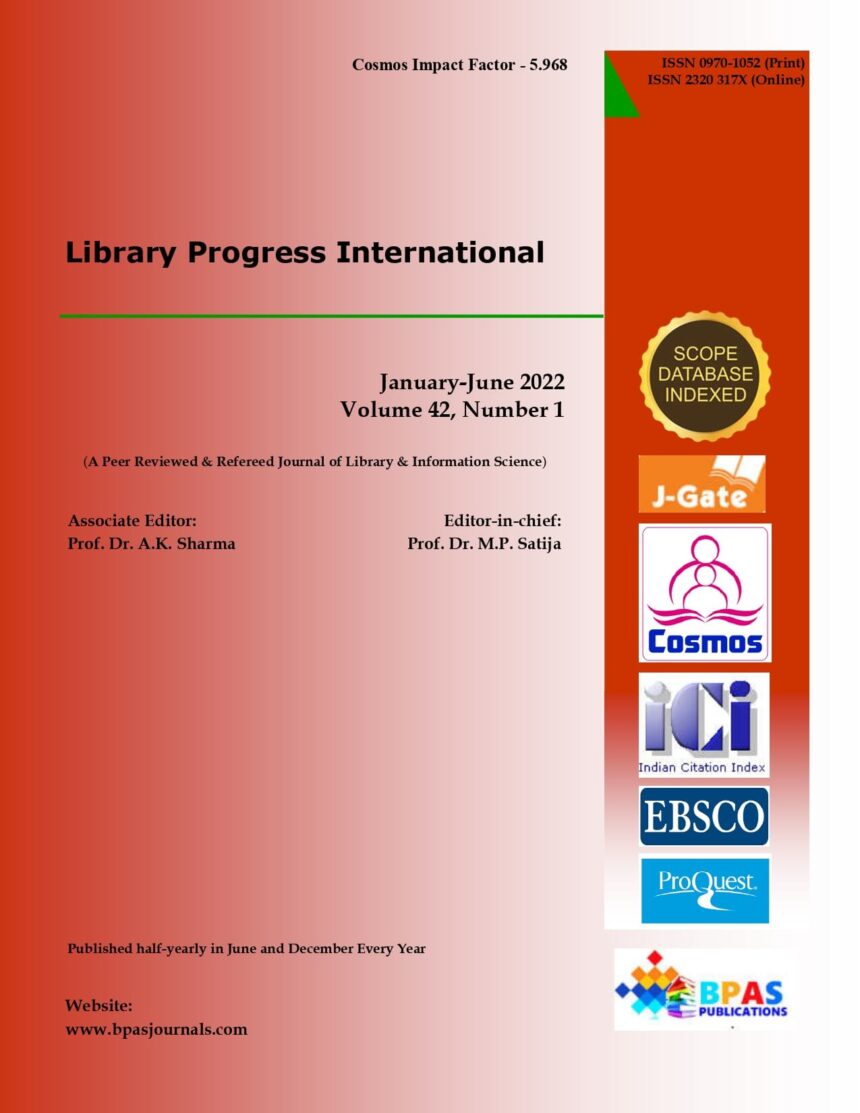Use of Folksonomies in Libraries: An Approach to Organise Information and Control Vocabulary
DOI:
https://doi.org/10.48165/Keywords:
Folksonomy, Library, Vocabularies, internet, taggingAbstract
The project investigates folksonomies as a novel strategy to organising information and controlling vocabularies in libraries; it is an inter-based information retrieval methodology comprised of community developed open ended labels that categorise library web resource material. It analyses the tools for folksonomies, such as delicious, flicks, and furls, as well as the usage of folksonomies in libraries, when and how to use them, and also the issues that militate against their use, such as their imperfection and annoyance with taxonomies, among others. The conclusion is that the folksonomy system produces great tags and maintains control over the vocabularies used in subject headers.
Downloads
References
Baker, K. (2012). Folksonomies and social tagging retrieved from http://theidiagholibrarianwordpress.
FeldMan, .B. (2010).What are Folksonomies. Retrieved from http://blog.shariglink.com/whatare folksonomies/61/.
Folksonomy (2007). In Wikipedia. The free encyclopaedia. Retrieved from http://www.en.wikipedia.org/wiki/folks onomy.
Golder, S.A and Huberman B.A. (2005). 'The structure of collaborative tagging systems. Information Dynamics Lab: Hp Labs, palo Alto, CA Retrieved from http://arxv.org/abs/cs.dl/0508082.
Kahlal, H. (2010). Controlled and uncontrolled vocabulary system retrieved from
http://www.google.com/search:client=m s-rim&hl=en.
Kaminski, L. (2009). Folksonomies boost web 2.0 functionality. OJNl 13(2) online journal of nursing informatics.
LISBD Network (2016), folksonomy retrieved from lisbdnetwork.com/ folksonomy
Mathes, A. (2014). “folksonomies – cooperative classification and communication through shared metadata”. Retrieve from http:/www.adammathes.com/academic/ computermediatedcommunication/folkso nomies.html.
Noruzo, A. (2006). Folksonomies: (UN) controlled vocabulary? Retrieved from http://www.eprint.rclis.org./10307/.
Pera, M.S, Lund, W., Ng, Y. (2009). A sophisticated library search strategy using folksonomy and similarity matching. Journal of the American Society for Information Science and Technology 60(7) 1392-1406
Porter, J. (200S). Folksonomies: A user - driven approach to organizing content. Retrieved from http://www.vanderwal.net/random/entr yseLphp?blog175
Shen, K. and Wu, L. (200S). Folsonomy as a complex network. Retrieved from http://arxiv.org/labs/csir/0509072
Shirky, .C. (2004). "Ontology is overrated: Categories, Links, and Tags." Retrieved from
http://www.shirky.com/writings/ontolo gy overrated.html.
Smith, G. (2008). Voices that matters series tagging: people. Powered metadata for the social web: Berkely, C.A: New Rider.
Spiteri, L. Controlled Vocabularies and Folksonomies. Presentation at Canadian Metadata Forum. Ottawa, Ontario; 2005. Retrieved from http://www:collectionscanada.gc.ca/obj/
/f2/014005-05209-e-epdf.
Steel, T. (2009). The new cooperative cataloging: Library Hitech, 27(1), 68-77. 17. Sturtz, D.N. (2008). Communal
categorization: the folksonomy. Retrieved from
http://www.davidsturtz.com/drexel/622 /communalcatgorization the folksonomy·.html
Tonkin, E. (2006). Folksonomies: the fall and rise of plain- text tagging. Retrieved from
http://www.ariandne.ac.uk/issue47/ton kin/info.html.
Udell, L. (2004). "Collaborative Knowledge Gardening" in InfoWorld, Retrieved from "'.
http://www.lnfoworld.com/article/04/0 8/20/340Pstrategi.html.
Wiki (2018) Ontology and Folksonomy. Retrieved from http/Wiki.org/index/php/ontology and folksonomy.
Wikipedia (2014). Folksonomy retrieved from http://en.wikipedia. org/w /index. php ?Utle=srecial: usabillity/ initiativePrefS
Willey, E. (2011). A cautious partnership: The growing acceptance of folksonomy as a complement to indexing digital images and catalogs. Retrieved from https://ir.library.illinoisstate.edu/cgi/vie
wcontent.cgi?article=1055&content=fpml.

